First HD Video Transmitted Directly from Seafloor to UC San Diego at National Ocean Exploration Forum

For the first time, live high definition video has been transmitted directly from the seafloor and onto a video display at a meeting of professional ocean explorers at the University of California, San Diego. The live feed was made possible by a fiber-optic undersea network known as the Ocean Observatories Initiative (OOI) off-shore “Cabled Array, which is funded by the National Science Foundation (NSF) and managed by the University of Washington (UW) School of Oceanography.
The captivating video feed portrayed in real-time the biological and physical dynamics of an active hydrothermal vent structure known as “Mushroom,” located within the ASHES hydrothermal vent field inside the caldera atop Axial Seamount, an undersea volcano one mile below sea level and about 400 km due west of Astoria, Oregon. One portion of the Cabled Array supports the most advanced submarine volcanic observatory in the world.
The high-definition mosaic of the entire Mushroom structure (Figure 1) and the real-time, live HD video imagery were displayed on a large, tiled 64-megapixel display wall (Figure 2) in the UC San Diego Qualcomm Institute (a division of the California Institute for Telecommunications and Information Technology) as part of the National Ocean Exploration Forum (NOEF).
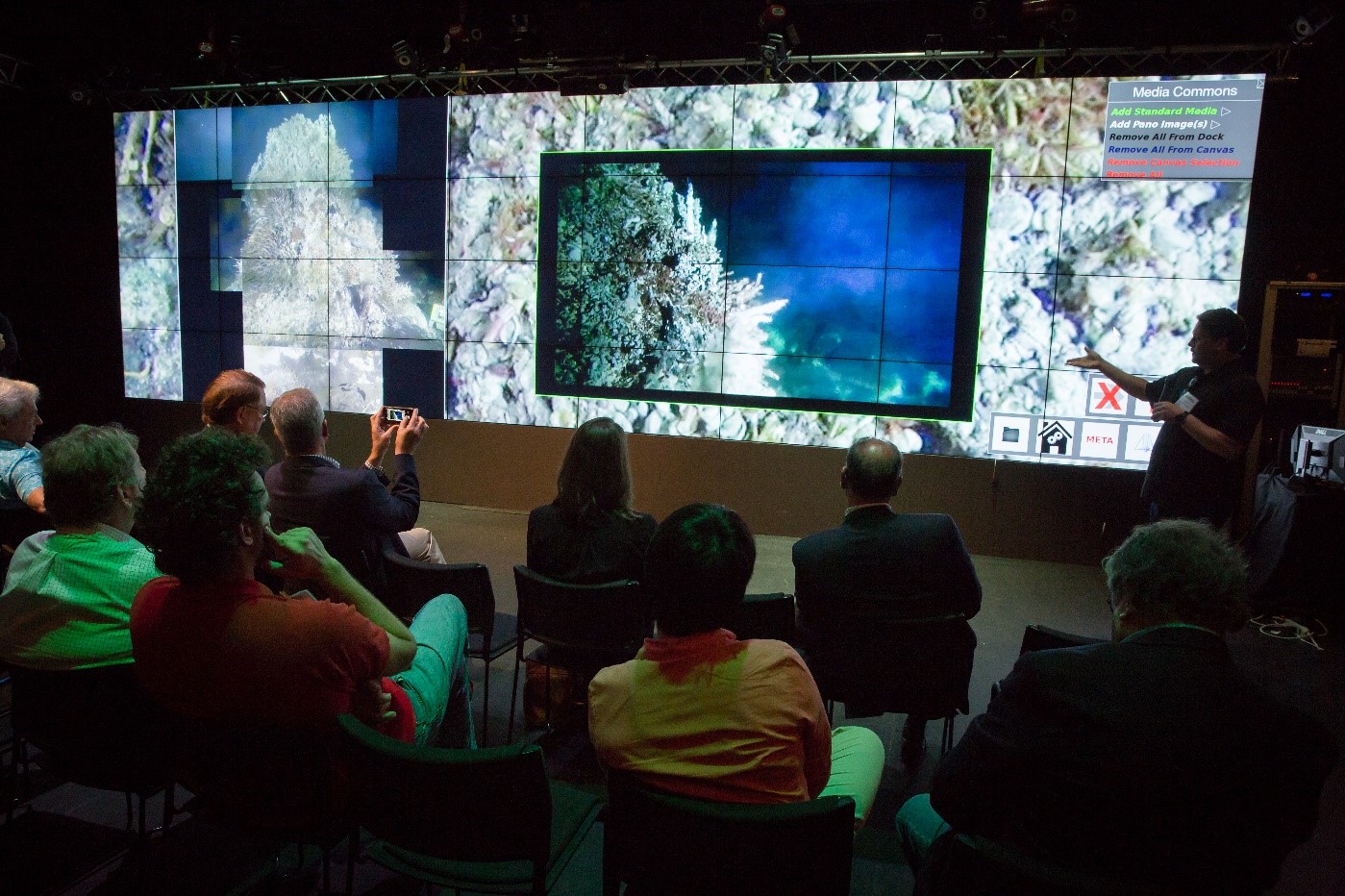
The 1080i high-definition camera, known as CamHD, is located on the seafloor directly opposite the Mushroom vent structure far below sunlight penetration depths. In lieu of the sunlight necessary for photosynthesis, a diverse community of organisms thrives on the microbial mediated chemosynthetic outputs of Mushroom driven by 250-degree Celsius water emerging from the volcanic activity below the ocean floor. Such systems are known to exist in more than 600 seafloor locations and constitute an integral part of the mid-ocean ridge volcanic network, which extends more than 70,000 km throughout all the ocean basins.
The seafloor presentation was one of a number of technology demonstrations in October 2017 at the fifth-annual National Ocean Exploration Forum held at Calit2’s Qualcomm Institute (QI). The Forum attracted nearly 125 data science and ocean exploration scholars interested in how data science analysis and visualization techniques can be applied to both contemporary, and historical, ocean exploration data.
The remotely controlled real-time video demonstration at the Forum was a memorable event for UW Professor of Oceanography John Delaney, principal investigator for the Cabled Array construction effort, and his longtime collaborator Larry Smarr, the Harry E. Gruber professor in the Department of Computer Science and Engineering at UC San Diego and Calit2 Director.
“It was deeply gratifying,” said Delaney, “to finally bring to fruition, before a distinguished group of ocean explorers, our long-sought-after vision of routinely interacting, in real-time, with a variety of rapidly changing ecosystems operating in the deep ocean more than 400 km off-shore.”
Margaret Leinen, Director of the Scripps Institution of Oceanography, agreed that the implications of the project are profound. "This demonstration shows that real-time ocean exploration from anywhere via the Internet is becoming possible, after decades of planning and NSF funding.”
The video above was edited from a 35-minute long real-time live stream of HD Imagery to Calit2’s Qualcomm Institute on October 21, 2017. The HD imagery from the camera captures in exquisite detail the tube worm communities and white bacterial filaments living on the chemosynthetic processes energized by the high temperature mineral-rich fluxes arising from below the seafloor.
A New Era in Human-Ocean Interactions
The Axial Caldera portion of the Cabled Array hosts more than 22 instruments (Figure 3) and is itself only a portion of the more than 140 instruments in the overall Cabled Array (Figure 4), which was deployed and made operational in 2014 as a part of the NSF OOI by Delaney and his UW team.
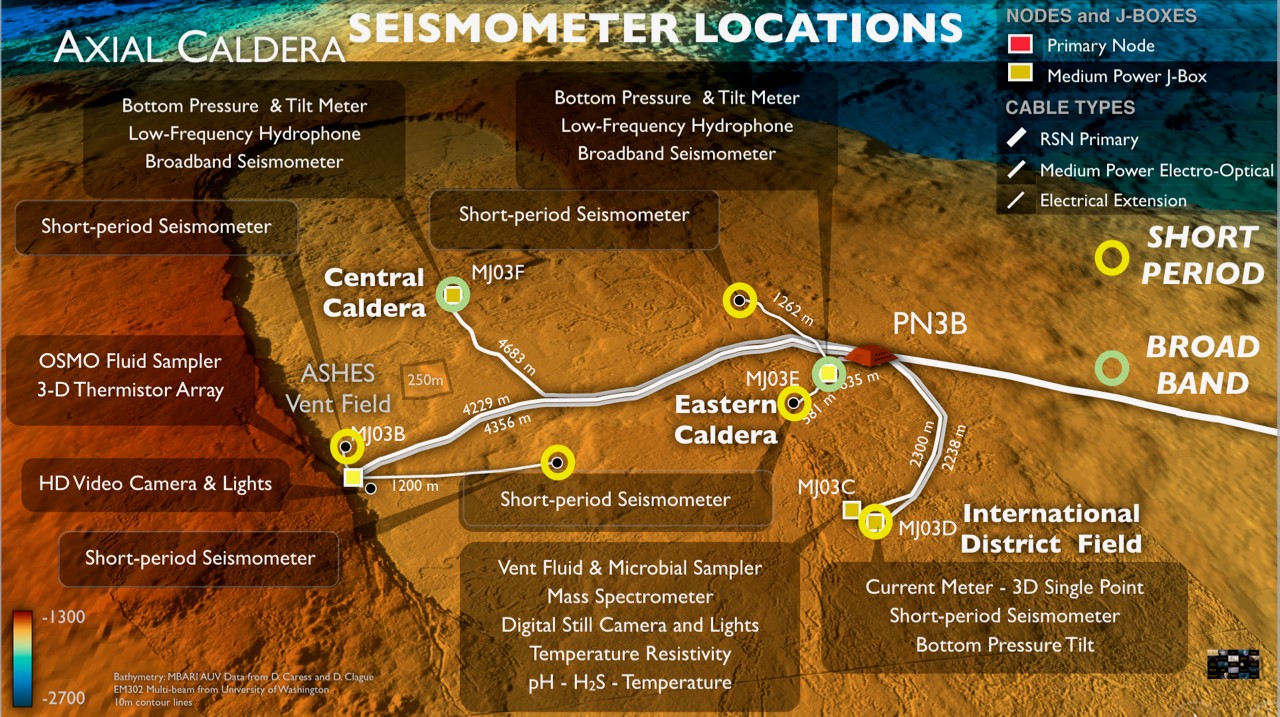
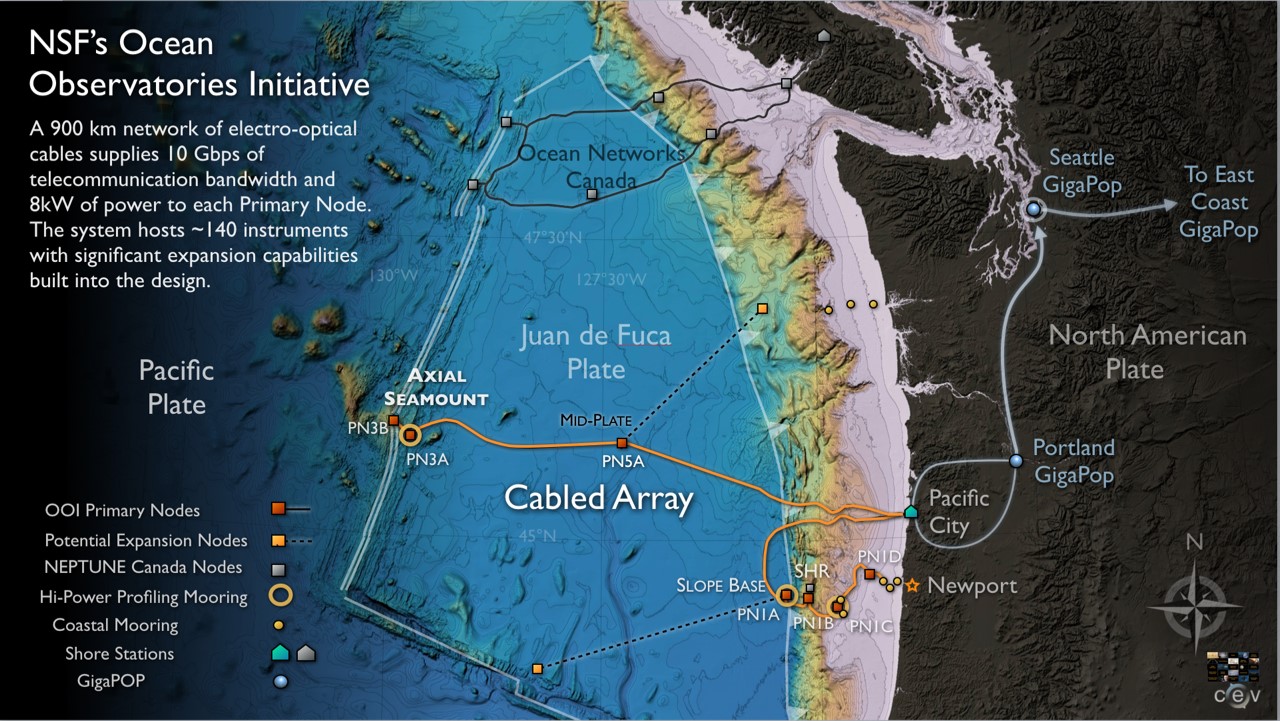
In this demonstration the CamHD video stream was transmitted from Mushroom as uncompressed, 1.5 Gbps HD video through the fiber-optic OOI subsea network to a video server located in Portland, Ore. The server produces a publicly available live stream via Pacific Northwest GigaPop’s (PNWGP’s) networks.
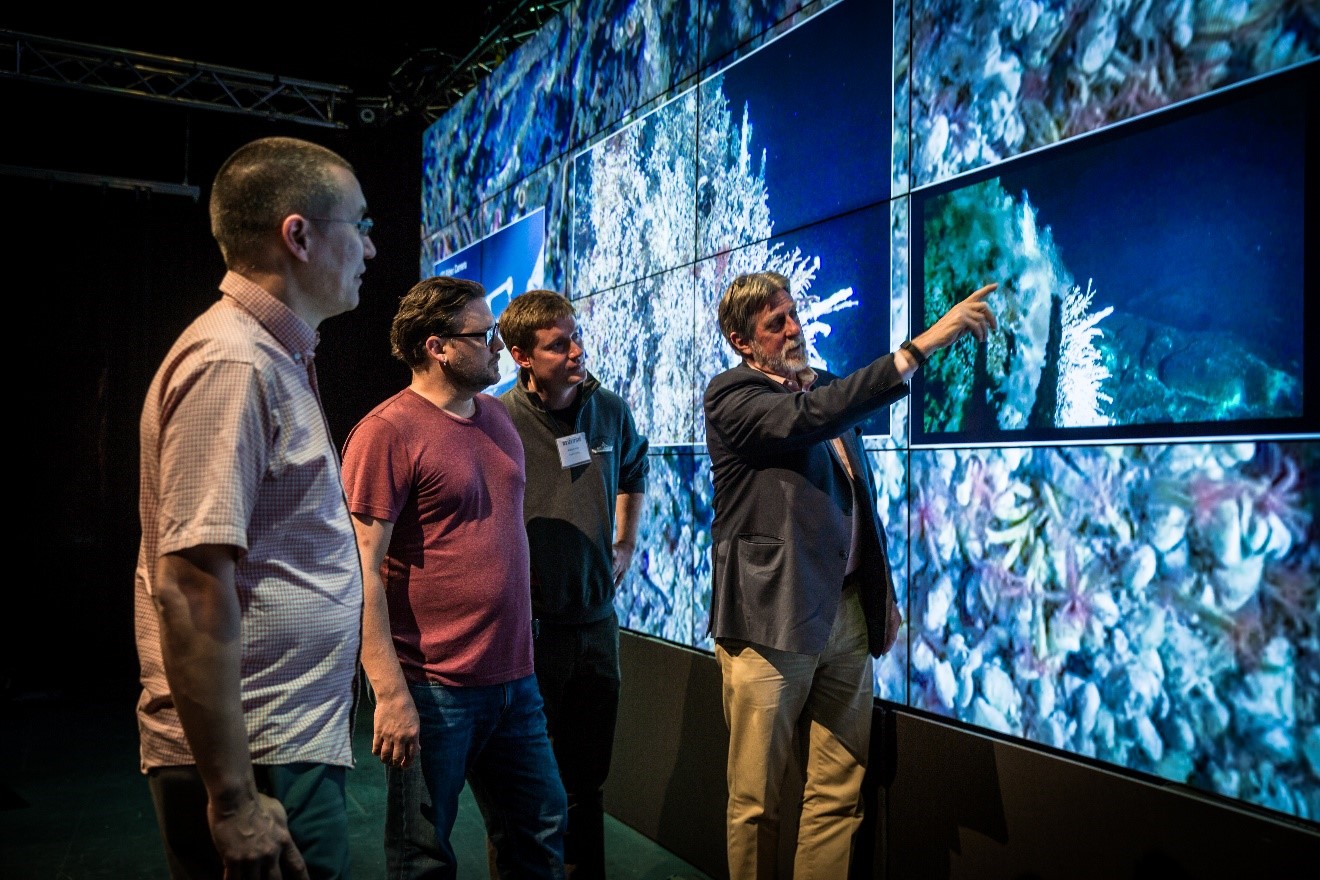
A key component of the OOI Cabled Array involves its capacity to allow remote control of the at-sea robotic CamHD, and other assets to be shifted to selected sites across the country. The first public demonstration of this capability was at NOEF in Calit2’s Qualcomm Institute. Aaron Marburg, a UW Applied Physics Laboratory Engineer, worked with colleagues from Lamont-Doherty Earth Observatory (Tim Crone) and from Rutgers (Friedrich Knuth) to operate the camera remotely over the Corporation for Education Network Initiatives in California (CENIC) and a portion of the NSF-supported Pacific Wave high-speed network, operated by PNWGP, to augment the routine daily transmissions from CamHD’s pre-programmed video scans.
From Bar Napkin to Big Screen
The live CamHD video feed from the ocean floor was initially conceived on a bar napkin at the 1991 meeting of the American Geophysical Union. The early vision was of a tectonic plate-scale undersea network of interactive laboratories, linked by submarine fiber optic cables. This idea evolved during the nineties into a program that Delaney dubbed “NEPTUNE" (North East Pacific Time-series Undersea Networked Experiments). The idea quickly gained traction with NSF, and in 2001 was put forth as a major part of a new NSF funding effort, the Ocean Observatories Initiative (OOI).
In January 2004, NSF held a workshop in Puerto Rico focused on OOI, which is where Smarr and Delaney first met. This meeting led to the idea of prototyping remote, real-time interactions with sea-floor systems. The prototyping concept became its own NSF proposal as an early collaborative effort between the UW (John Delaney, Principal Investigator (PI), and Co-PI’s Ed Lazowska, Ron Johnson), UC San Diego (Co-PI’s John Orcutt, Larry Smarr) and Oregon State University (Co-PI Mark Abbott). Funded in late 2004, the $3.9 million Laboratory for the Ocean Observatory Knowledge Integration Grid (LOOKING), developed early versions of software, hardware and network services to allow researchers, educators and students to access and to analyze ocean and atmospheric data in real time.
In 2005, a crucial early proof-of-concept used live satellite transmissions from the UW Research Vessel Thomas G. Thompson to UW to simulate a future seafloor cabled system. The video signal was relayed via satellite to the UW campus and then onto Calit2 by Pacific Wave fiber-optic links. Calit2, as part of iGrid2005 hosted a global transmission of the HD signal to Sydney, Amsterdam, Bejing, and to NSF in Washington, DC, with only seconds delay from seafloor to on-sight display before global assembled audiences.
The LOOKING prototype experiment laid the groundwork for the OOI, led by the Joint Oceanographic Institutions (JOI), a consortium of leading U.S. oceanographic research institutions (including UC San Diego and UW), hich awarded multimillion dollar contracts in 2007 to support the development and operations of the OOI. The award to UC San Diego was for the computer architecture or cyberinfrastructure portion of the OOI, led by SIO’s John Orcutt, collaborating with Calit2 and the San Diego Supercomputer Center. The OOI program funded UW (led by Delaney) to deliver the cabled undersea network off the coast of Washington and Oregon in November of 2009.
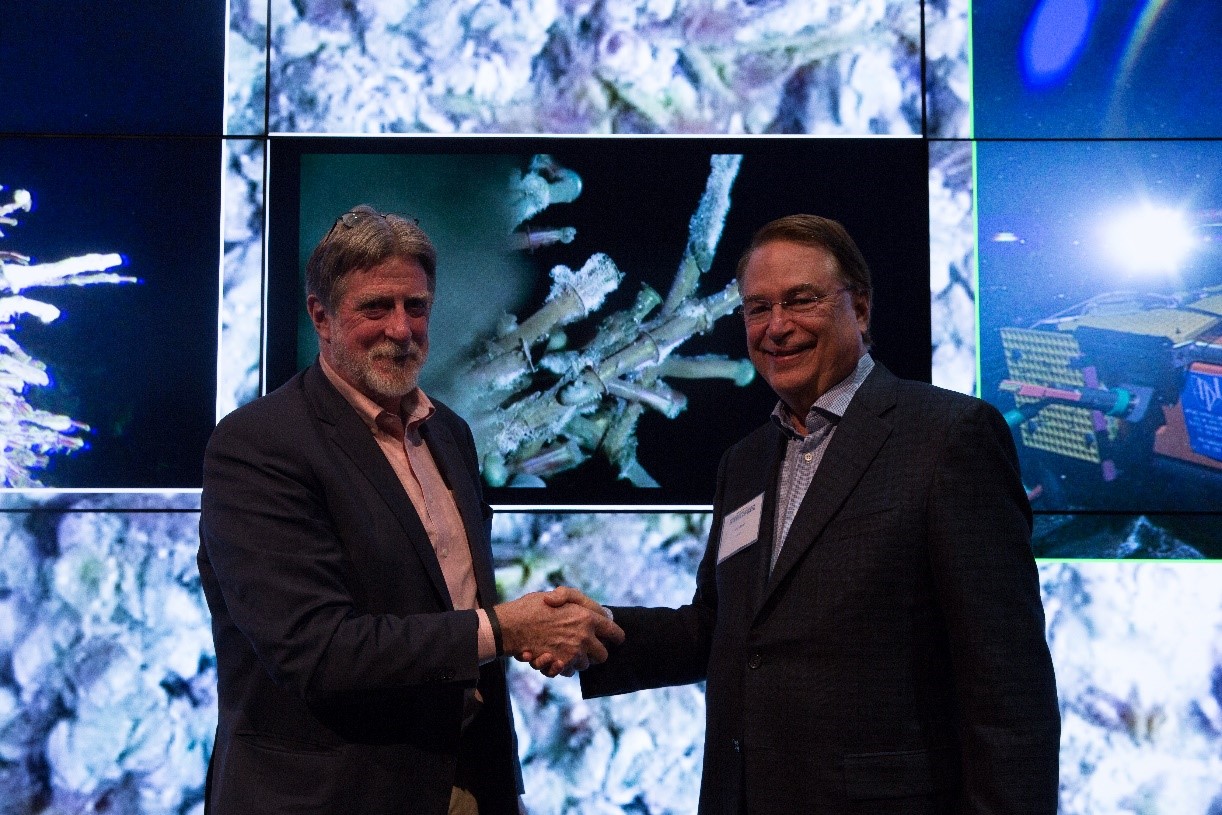
Final designs and construction of the cabled system commenced immediately and involved a team of scientists and managers in the School of Oceanography at UW, the overall engineering team at the Applied Physics Laboratory within the UW, and a construction corporation: L3-Maripro. Initial operation of the cabled system was completed, on time and under budget, after many months of at-sea construction in October of 2014.
The culmination of the 13-year journey -- which began when Smarr and Delaney met in Puerto Rico -- made the CamHD Demo at NOEF a jaw-dropping moment for Smarr.
“I stood there not really being able to believe that the dream that John and I have had for so long was actually happening,” added Smarr.
Related Links
2017 National Ocean Exploration Forum
U.S. National Oceanographic and Atmospheric Administration
Media Contacts
Tiffany Fox
(858) 246-0353
tfox@ucsd.edu
